The Balkans is a fascinating and increasingly popular destination for English-speaking tourists. It can also be very affordable. Getting around the region, however, can be confusing, particularly if you want to cross the region from one coast to another, from Europe to Asia.
A particularly popular route is that from Croatia to Turkey. This passes through a selection of the Balkan states, and can be spread across weeks – even months – or done in two or three days. This article will break down how best to take that route. Fortunately, it is possible to do the journey entirely by coach and bus for a very reasonable price and with little to no advance booking.
Transport overview for the Balkans
The Balkans are poorly served by trains. While there are a few lines, they are not useful for getting between countries, can be expensive, and also do not run frequently.
Similarly, you’ll find that while airports do exist, they are generally smaller with fewer flights and can therefore be expensive. However, the good news is that buses – the main form of transport for people living in the Balkans, aside from cars – are regular, affordable and reasonably comfortable.
The trick, however, is working out your route from the huge number of local services and timetables. The bus companies rarely put information online, so it’s a case of turning up at the bus station and doing a mixture of detective work and guessing. Hopefully, this guide will take some of the confusion out of this process, and allow you to simply enjoy the journey.
Buying bus tickets and finding schedules in the Balkans
While English is spoken in the region, particularly in Croatia, Montenegro and Bulgaria, websites and schedules are rarely translated. That being said, once you find a timetable online – or on paper – it is not too hard to work out what they are saying (timetables mostly looking the same wherever you go).
Use a dictionary to get a sense of how the timetable is organised (e.g., services run differently in the high and low season). Fortunately, however, local services run very frequently, so this should not present a major problem. Just turn up at the station and wait for your coach.
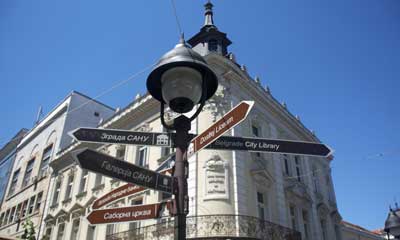
The Travel Club website has some information and a forum, including travelogues by people using transport in the region which, while not providing concrete information, give a sense of what buses in the region are like.
For the most part, finding your bus is made easier by the fact that the buses will often have a printed-out yellow or white sign in the driver’s window with at least the main destination printed on it, the service number, and usually the other principle stops. You won’t need excellent language skills to go up to the driver and say the name of the place you want to go. Sometimes you’ll get an English-speaking driver who’ll give you a bit more information, sometimes not.
In most cases, tickets are purchased on the bus – the driver will come along the aisle and take your destination and money. In some cases, such as for international coaches or the coach station in Dubrovnik, you need to purchase the tickets at the kiosk.
Because most buses run regularly, you can simply turn up without reservations and buy the ticket directly (they operate on a first-come, first-served basis). Make sure that the driver knows you have luggage – they charge a fee to stow it underneath, and won’t be happy if you try and cram it on with you.
Don’t always expect a toilet on board. The drivers, if they don’t speak English, will also only announce rest-break stops in their language. Hang around close to the bus so that you don’t get left behind.
Some useful links:
- Belgrade Bus Station (not in English)
- Serbian railways (in English)
- Montenegro transport site: (in English, partly, includes numbers for bus stations and some schedule information)
- Nis Express (not in English) – click on Prevoz putnika (passenger transport) > Red vožnje (schedule) for a basic timetable searcher
- Metro tourism (Turkey) (English option)
- Bus Croatia (in English)
- Avtogari (Bulgaria) (in English, partly. Some information about inter-urban bus schedules)
- Rome2Rio (can be useful to get a sense of whether a route is possible or not, though the actual bus information can be hit and miss).
Croatia transport overview
Dubrovnik, the “jewel of the Adriatic”, is a key point of interest for tourists, but also an excellent place from which to delve deeper into the Balkans.
Getting to Dubrovnik
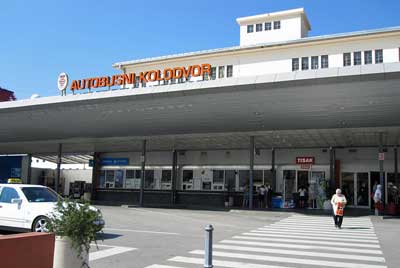
An overnight ferry can by taken from Bari, southern Italy, to Dubrovnik as well as to a number of other destinations in Albania and Croatia (such as Split). The overnight ferry is not particularly comfortable, and has something of the ghost ship about it, but for those already in Italy it is a huge lifeline.
It is strongly advisable to book the ferry online through the Jadrolinija website in advance. It costs about £45 per person (including fees) for the “seating” fare. There is a slightly cheaper option called “deck”, which requires that you sleep in corridors. Cabins can be booked for considerably more.
The company will send you a number of documents for travel, but they are not your boarding passes. To obtain your boarding pass you must collect this, in person, from the Jadrolinija stall in Bari port (a free bus will take you there and drop you back at the terminal after 6pm). The ferry leaves at 10.30pm.
Alternatively, you can get a coach from Split, which is further up the Adriatic coast. The journey takes between 4 – 6 hours, and costs around 125 Kuna for a single and about 200 Kuna for a return (about £13 and £20 respectively).
Tickets can be purchased at the Split bus station. This website with an English option, has additional information. You will pass through Bosnia & Hergezovina along the route – check before you travel that this will not complicate acquiring visas with other countries in the region. If in doubt, contact your embassy – they are surprisingly helpful and quick to respond, in most cases.
Dubrovnik to Montenegro
A lot of English-speaking tourists want to head on through Serbia, reaching – eventually – Istanbul. As I said, you cannot currently do this as a single leg. Your best option, discounting a flight, is to take a coach onward to Montenegro, and to get a connection from there.
The coach station in Dubrovnik is located on the quay, close to the terminal building where the ferry arrives. You will need no more than 15 Euros per person to get an onward ticket to Montenegro (Herceg Novi). To go further costs more, but never becomes prohibitive.
These coaches head to a number of destinations, including Herceg Novi, Kotor and Podgorica (the capital of Montenegro). If you’re planning on heading on to Albania, going to Podgorica is the best option. Note: you will need to pay anywhere from 0.50 cents to 1 Euro to stow each piece of baggage on the coach. Don’t put your own luggage underneath, as the driver will remove it. Approach him directly to pay and stow.
It takes about two-three hours to get to Herceg Novi, with a lengthy wait at the dual border points. Here, the driver will ask for your passport and will obtain the stamp. There is no fee.
Montenegro
Herceg Novi is principally a Serbian/Russian resort town. It’s among the first and arguably most useful places in this part of Montenegro for onward travel. The main coach station handles both local and international coaches.
Moving on
From Herceg Novi it is possible to get to Serbia (either Nis or Belgrade) and to other Montenegrin destinations (Kotor/Podgorica). The bus drivers at Herceg Novi will sometimes tout for fares, offering more competitive prices and advice about local connections.
You can buy a ticket inside the coach station. It costs around €25 in cash (there is no card reader). ATMs can be found in the town centre; a 15-minute walk away. The “Nis Express” is unmistakable – a large, red coach with “Nis Express” written on the side in white. In departs once a day in the low season, and 2/3 times a day in the high season.
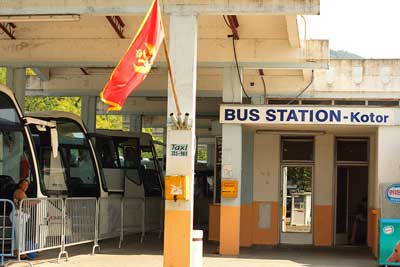
The coach is unlikely to have a toilet. However, it does stop here and there along the way for rest-breaks.
In addition, you can take a local bus to Kotor, taking about 2 hours. Kotor is a beautiful place to spend a few days. Even though it is the primary tourist destination in Montenegro, the prices are not much different from other places.
Food, beer, and cigarettes are particularly cheap. It costs no more than €4 for a single ticket. During Easter, expect to be given Easter Eggs nearly everywhere you go – including on buses.
Serbia (Nis and Belgrade)
Centrally located in the Balkans, Serbia is the best location from which to explore a number of adjoining countries.
From Nis to Bulgaria
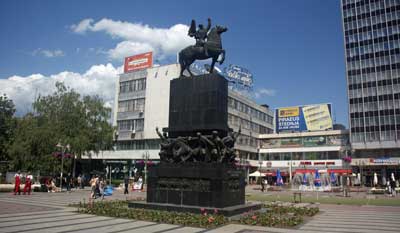
However, you can get a train to Sofia, though it is more expensive than the coach. This leaves at around 1:40am. Note: the timetable boards in the station do not, confusingly, display accurate times. Ask at the desks for the right fares and times. Outside the station is a Eurolines stall, with coaches to northern Europe (Paris, Vienna, Prague). It is not always open (prices are available on the Eurolines website. For example, a coach to Munich will cost about 80 Euros).
The coach station is a better option. Times are more frequent and the staff are quite helpful. From here you can get coaches to Belgrade, Montenegro (Podgorica/Herceg Novi, etc), Greece, Macedonia and Albania. The Sofia bus leaves around 4pm. It costs less than €12 and will get you to Sofia in about 4 hours. It stops at a border garage for a rest break.
Sofia to Turkey
Sofia coach and train station are helpfully sited together. The coach station is huge, with a number of company stalls (or, shops) from where you can book advance tickets or on-the-day bookings.
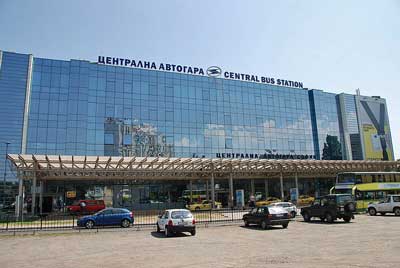
Istanbul coach station – interior of Turkey
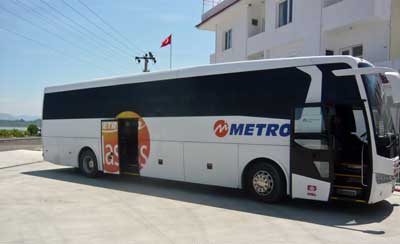
From here you can get affordable coaches to mainland Turkey, Greece, Romania, Bulgaria and the Balkans, as well as central Europe. Some coaches run to the Middle East.
Metro and tram services can be taken within Istanbul, costing only €3 per journey for as far as you can go. As buses leave so regularly, it’s not necessary to worry about specific times. Needless to say, you can simply turn up at the bus company stalls at the station and get your ticket or reservation direct.
Coaches leave to Ankara every 15-25 minutes, 24 hours a day, and take 5-6 hours (with Varan, this costs 50TL). Companies include Varan, Istanbul Seyahat and Ulusoy. Of these, Varan is particularly good, though their bus stops are not always located in the main bus terminal. They run free transfer services from Taksim and Sultunhamet.
Currently, you cannot use Hyderpassa station, on the “Asian” side of the city, to get to Ankara and eastern Turkey. This is due to the same problems that afflict the Balkans Express (namely, improvement works).
When it does run again, you can get from Hyderpassa to Ankara overnight in great luxury and comfort for very little money. Needless to say, the dining car – well stocked with wine and meat – is a thing to behold. For now, coaches are the best bet – swift and affordable (free biscuits, also).
Finally
The route from the Adriatic coast to western Turkey is exciting and extremely varied. It is also a very cheap way of seeing a lot of countries in a short space of time.
Because you can simply, for the most part, arrive and book your tickets on the day, it is possible to take as long as you want, and to follow whatever diversions appeal to you long the way.
By Owen Vince
Additional photo credits: Dubrovnik coach station by traveldot on Flickr, Kotor coach station by Antti T. Nissinen on Flickr, Sofia station by Jaime Pérez on Flickr
